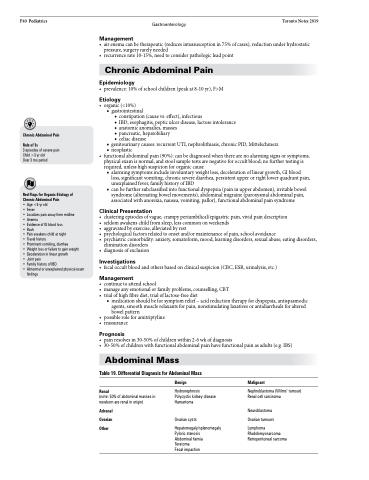Page 1074 - TNFlipTest
P. 1074
P40 Pediatrics
Gastroenterology Toronto Notes 2019
Chronic Abdominal Pain
Rule of 3s
3 episodes of severe pain Child >3 yr old
Over 3 mo period
Red Flags for Organic Etiology of Chronic Abdominal Pain
• Age <5 yr old
• Fever
• Localizes pain away from midline
• Anemia
• Evidence of GI blood loss
• Rash
• Pain awakens child at night
• Travel history
• Prominent vomiting, diarrhea
• Weight loss or failure to gain weight
• Deceleration in linear growth
• Joint pain
• Family history of IBD
• Abnormal or unexplained physical exam
findings
Management
• airenemacanbetherapeutic(reducesintussusceptionin75%ofcases),reductionunderhydrostatic pressure, surgery rarely needed
• recurrencerate10-15%,needtoconsiderpathologicleadpoint
Chronic Abdominal Pain
Epidemiology
• prevalence:10%ofschoolchildren(peakat8-10yr),F>M
Etiology
• organic(<10%)
■ gastrointestinal
◆ constipation (cause vs. effect), infectious
◆ IBD, esophagitis, peptic ulcer disease, lactose intolerance ◆ anatomic anomalies, masses
◆ pancreatic, hepatobiliary
◆ celiac disease
■ genitourinary causes: recurrent UTI, nephrolithiasis, chronic PID, Mittelschmerz
■ neoplastic
• functionalabdominalpain(90%):canbediagnosedwhentherearenoalarmingsignsorsymptoms,
physical exam is normal, and stool sample tests are negative for occult blood; no further testing is required, unless high suspicion for organic cause
■ alarming symptoms include involuntary weight loss, deceleration of linear growth, GI blood loss, significant vomiting, chronic severe diarrhea, persistent upper or right lower quadrant pain, unexplained fever, family history of IBD
■ can be further subclassified into functional dyspepsia (pain in upper abdomen), irritable bowel syndrome (alternating bowel movements), abdominal migraine (paroxysmal abdominal pain, associated with anorexia, nausea, vomiting, pallor), functional abdominal pain syndrome
Clinical Presentation
• clusteringepisodesofvague,crampyperiumbilical/epigastricpain,vividpaindescription • seldomawakenschildfromsleep,lesscommononweekends
• aggravatedbyexercise,alleviatedbyrest
• psychological factors related to onset and/or maintenance of pain, school avoidance
• psychiatric comorbidity: anxiety, somatoform, mood, learning disorders, sexual abuse, eating disorders, elimination disorders
• diagnosisofexclusion
Investigations
• fecaloccultbloodandothersbasedonclinicalsuspicion(CBC,ESR,urinalysis,etc.)
Management
• continuetoattendschool
• manageanyemotionalorfamilyproblems,counselling,CBT • trialofhighfibrediet,trialoflactose-freediet
■ medication should be for symptom relief – acid reduction therapy for dyspepsia, antispasmodic agents, smooth muscle relaxants for pain, nonstimulating laxatives or antidiarrheals for altered bowel pattern
• possibleroleforamitriptyline • reassurance
Prognosis
• painresolvesin30-50%ofchildrenwithin2-6wkofdiagnosis
• 30-50%ofchildrenwithfunctionalabdominalpainhavefunctionalpainasadults(e.g.IBS)
Abdominal Mass
Table 19. Differential Diagnosis for Abdominal Mass
Renal
(note: 50% of abdominal masses in newborn are renal in origin)
Adrenal Ovarian Other
Benign
Hydronephrosis Polycystic kidney disease Hamartoma
Ovarian cysts
Hepatomegaly/splenomegaly Pyloric stenosis
Abdominal hernia
Teratoma
Fecal impaction
Malignant
Nephroblastoma (Wilms’ tumour) Renal cell carcinoma
Neuroblastoma Ovarian tumours
Lymphoma Rhabdomyosarcoma Retroperitoneal sarcoma


